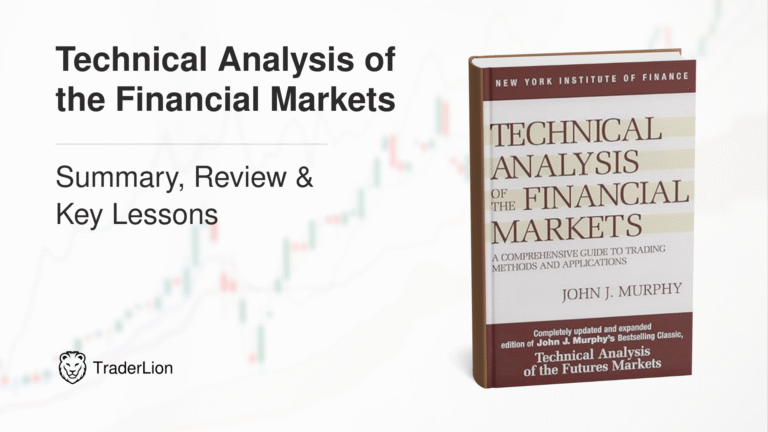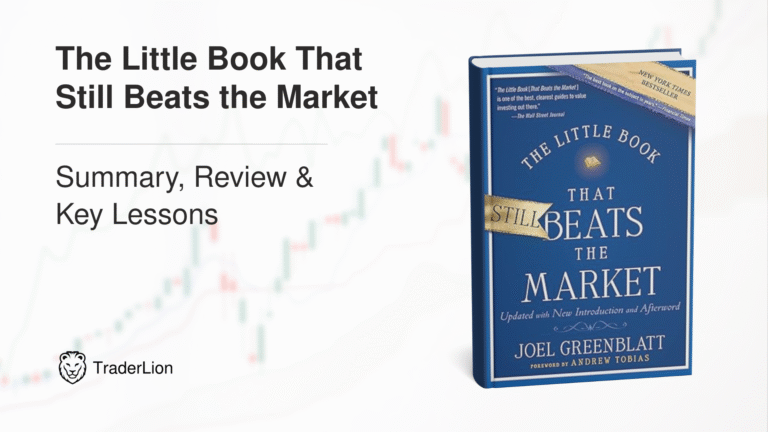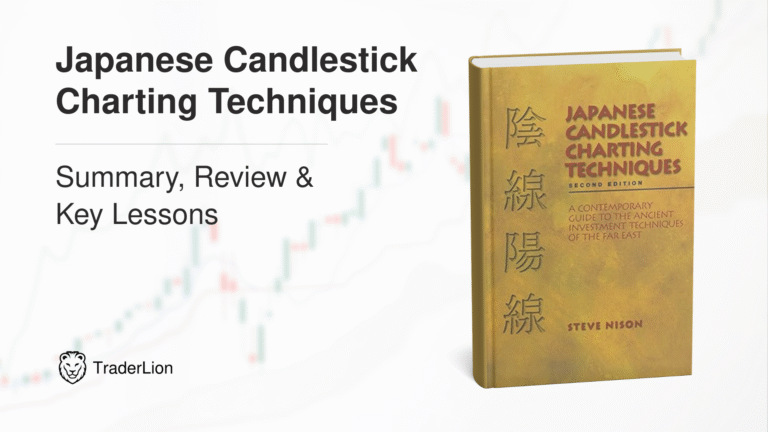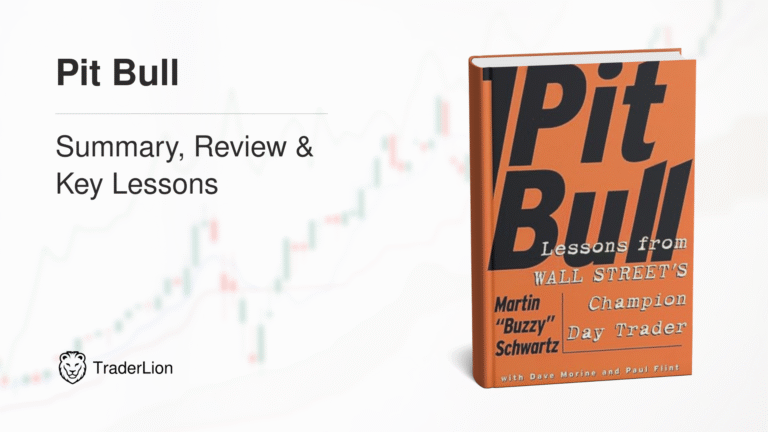
Technical Analysis of the Financial Markets Summary, Review & Key Lessons for Traders
Published: August 26, 2025
Every trader knows the pain of chasing entries, late exits, and mixed signals that do not line up across timeframes. That frustration usually comes from a weak market model and inconsistent chart work. John J. Murphy’s Technical Analysis of the Financial Markets fixes that problem at the foundation. It lays out a full visual language for price, volume, open interest, and trend. It explains why markets discount everything, why prices move in trends, and why certain patterns repeat. It also shows how to build a plan that respects the primary, secondary, and minor trend, how to measure pullbacks, and how to manage risk when price violates structure. The early chapters cover philosophy, Dow Theory, chart construction, and the basic concepts of trend with clean diagrams. Later chapters stack on reversal and continuation patterns, moving averages, oscillators, market profile, risk, and system design.
If entries feel random and stops feel like guesses, Murphy gives a step by step workflow. The book’s figures make it concrete: how to draw valid trendlines, when a small penetration matters, how channels set targets, how gaps differ, and why weekly and monthly perspectives protect you from intraday noise. The Dow Theory section defines the big picture. The trend chapter shows support, resistance, and the flip where resistance becomes support. Reversal chapters teach head and shoulders, double tops and bottoms, and volume confirmation. Continuation chapters add triangles, flags, and measured moves. By the end, you can read a chart the same way every day, across any market or timeframe, and you have clear rules for what invalidates your idea.
Quick Facts About Technical Analysis of the Financial Markets
Who Is John J. Murphy and Why Listen?
John J. Murphy is one of the most cited names in technical analysis. He served as the technical analyst for CNBC for seven years, after years in futures technical research and as a senior managed account trading advisor with Merrill Lynch. He has authored multiple books that are considered core texts for technicians. His work is used in the Chartered Market Technician program, which signals how deeply it maps to professional practice. The About the Author page in this edition notes his consulting firm, JJM Technical Advisors, and his software company MURPHYMORRIS, INC., founded with developer Greg Morris, both focused on giving traders practical charting tools that mirror the techniques in the book. This blend of research, media communication, and direct work with traders gives his writing a grounded, applied tone. He does not just list patterns. He tells you when they fail, how to size expectations, and how to link multiple tools so your decision chain stays simple.
What is Technical Analysis of the Financial Markets About?
Murphy builds a full system. He starts with the philosophy that market action discounts everything, prices trend, and history repeats, then contrasts technical and fundamental work and separates analysis from timing. He then teaches Dow Theory, which frames the primary, secondary, and minor trend and requires confirmation across averages.
Next he shows how to construct charts and why scale matters, then defines trend with support, resistance, channels, and retracements with clear rule sets and diagrams. He follows with reversal and continuation patterns, volume and open interest, long term charts, moving averages, oscillators, Market Profile, risk, systems, and more, each with measurement rules and failure warnings.
Technical Analysis of the Financial Markets Chapters at a Glance
Why Technical Analysis of the Financial Markets is a Must-Read
Murphy solves the main problem most traders have: mixing timeframes and tools without a hierarchy. Early on he separates analysis from timing. Analysis defines trend, structure, and context. Timing triggers the trade. That split removes a lot of noise. The book’s treatment of Dow Theory puts you on the right side of the primary trend before you even think about entries. His definition of support and resistance, the role reversal after a decisive break, and the use of trendlines and channels give you a map for price. The chapter on retracements sets practical zones that show where pullbacks tend to end. When price ignores structure, that is your risk signal and a cue to reduce or exit. The result is a rule based way to trade momentum without guessing.
The pattern chapters are equally practical. Head and shoulders comes with a clear layout, the requirement for volume to confirm, and a measured move target based on the height of the pattern. Double tops and bottoms include filter rules so you do not short every two peak structure you see. Continuation patterns teach triangles, flags, and measured moves so you can hold through consolidations with logic. The weekly and monthly reversal section shows why higher timeframe climaxes matter more than daily noise. Later sections round out the toolkit with moving averages, oscillators like RSI, MACD, and Stochastics, and a smart discussion of when oscillators work best. Add Market Profile and the system building chapter and you have a full path from idea to tested rules.
Top Lessons to Apply to Your Trading
1. Respect the primary trend before timing entries
Trend is the context that pays most of the edge. Dow Theory divides trends into primary, secondary, and minor and requires confirmation across related averages. Use the weekly chart to identify the primary trend, then plan trades on the daily and execute on the intraday. If the weekly trend is up, prefer long setups. If the weekly trend is down, prefer shorts or sit out. Link that to structure. Draw the dominant trendline and the parallel to form a channel. A pullback to channel support with weakening downside momentum is an entry window, not a reason to predict a top. Place stops where the structure fails, not where you hope to be right. If price closes through channel support and cannot recover on the next bar, accept the change in character and cut. This alignment reduces fight trades and improves hold time because you are no longer trading against the backdrop that controls most of the variance.
2. Use support, resistance, and role reversal to set risk
Support and resistance are not lines you draw after the fact. They are levels defined by prior pivots where order flow flipped. In an uptrend, prior highs often become support after a decisive break. In a downtrend, prior lows become resistance. Role reversal is a test of conviction because it forces you to ask whether the market accepted the breakout. On a retest, look for a higher low, contracting ranges, and lighter volume against the level. That is your low risk entry. Your stop belongs just beyond the level, not far away. If the market blows through on above average volume, do not average down. The level failed. Reverse roles and treat that level as resistance on the next rally. This single concept cleans up most entries and exits because it gives you one clear map for where you are wrong.
3. Measure pullbacks and patterns rather than predicting
Murphy shows simple, repeatable measurements. Retracements often run one third to two thirds of the prior swing, with 50 percent as a common anchor. Head and shoulders targets equal the height of the pattern projected from the neckline break. Triangles and flags come with measured move logic. These measurements prevent two errors: overconfidence in trend persistence and panic on normal pullbacks. If you expect a 33 to 66 percent retracement, a garden variety dip will not knock you out. If a pullback exceeds that zone and breaks the trendline on a closing basis, you know momentum shifted. Measuring puts trades on rails. It reduces debate and helps you compare setups across markets. It also keeps you honest. When the target is hit, take partials or trail with intent rather than invent new targets on the fly.
4. Match indicators to market conditions
Oscillators shine in ranges and lose power in strong trends. Moving averages smooth trends and add clarity in directional markets. Murphy’s approach is to group tools by condition. In a trend, rely on moving averages, channels, and breakouts. In ranges, use RSI, Stochastics, and MACD crosses around the zero line, and watch for divergences. Combine indicators, but only where they answer different questions. A 50 day moving average answers trend direction. RSI answers momentum stretch. Volume answers conviction. If all three align with price structure, take the trade. If they fight each other, pass. Keep settings simple and stable. Frequent changes are usually curve fitting. Most edge comes from clear structure, not exotic math. Fit the tool to the tape you are trading and your win rate will reflect the match.
Common Mistakes Technical Analysis of the Financial Markets Helps You Avoid
1. Trading without a top down process
Many traders scan intraday patterns without a higher timeframe read. That invites trades against the primary trend and poor hold decisions. Murphy’s sequence fixes this. Start with weekly and monthly charts to set bias. Move to daily for setups in the direction of that bias. Finish with intraday for precise entries. This structure also improves risk management. You will stop buying breakdowns and shorting breakouts because the higher timeframe says the opposite. The top down process reduces idea churn, helps you manage exposure, and makes it easier to execute because the plan is already aligned with the big picture.
2. Confusing any two peak pattern with a double top
A valid double top needs more than two highs. You want a clear swing between the peaks, a decisive close through the intervening low for confirmation, and often a filter such as a close beyond the level by a small percentage to avoid noise. Volume should contract into the second peak and expand on the breakdown. If price wobbles around the low and closes back above, the pattern failed and you should exit rather than hope. The same logic applies to double bottoms. These rules prevent premature shorts and make sure you only act when the structure breaks, not when it merely looks symmetrical.
3. Ignoring role reversal after a breakout
Traders often buy the first breakout and then freeze during the retest. Murphy treats the retest as a normal process step. If the breakout is real, the prior resistance should act as support on a pullback. Look for a higher low at or just above the level with lighter downside volume. That is your second chance to participate. If price slices back through on heavy volume, the market rejected the breakout. Exit and reassess. Respecting role reversal means you stop averaging into failed moves and you use the retest to size with less risk and more confidence.
Best Quotes from Technical Analysis of the Financial Markets
“Market action discounts everything.”
This premise means price already reflects known information and a lot of unknowns through positioning. Treat price as the final arbiter. Build a process that reads trend, structure, and momentum rather than trying to parse every headline. This mindset frees you from overreacting to news and anchors you in the tape. It also explains why technicals work across assets. If crowd behavior and order flow drive price, the same tools apply to stocks, futures, and currencies. Use this premise to simplify your inputs and focus on what the market is doing, not what you think it should do.
“Prices move in trends.”
This is the basis for trend following and for the idea that you can hold winners longer than you can predict exact turning points. If prices trend, your job is to join the move and manage pullbacks. Use trendlines and channels to define the path and moving averages to smooth the noise. When price violates the structure on a closing basis and fails a role reversal test, accept that the trend likely changed. This belief pushes you toward risk first behavior. You will cut when the trend breaks and hold when it does not, which is how most equity curves improve.
“History repeats itself.”
Patterns repeat because crowd behavior repeats. Head and shoulders, triangles, and flags are not magic. They reflect distribution, consolidation, and continuation that recur as traders cycle between fear and greed. Using repeating structures lets you define entries, stops, and targets with clear rules. The key is not to memorize shapes but to understand what they represent. Volume confirmation on a head and shoulders top is not a superstition. It shows supply finally overwhelming demand. Treat patterns as visual summaries of behavior and your decisions will become both faster and calmer.
Who Should Read Technical Analysis of the Financial Markets
This book is for active traders who want a full chart based method. If you trade stocks, futures, or options and need a clean framework to spot trend, define risk, and time execution, start here. Newer traders will learn a common language. You will know what an uptrend is, how to draw a valid trendline, when a channel break matters, and how retracements set expectations for the next move. The diagrams in the trend chapter and the multi time frame examples make it easier to learn than a screen full of indicators. If you have been adding tools without a model, this book helps you strip back to core structure.
It is also for experienced traders who feel their process has drifted. If entries vary by feel or exits depend on hope, the sections on pattern measurement, volume confirmation, and failure rules will tighten execution. Swing traders will use the reversal and continuation chapters. Position traders will lean on weekly and monthly charts for bias. Futures traders will learn how open interest and contract structure change the read. System traders will benefit from the checklist and the 5 step plan for turning a concept into objective rules. This book is not for anyone looking for a black box or a secret setting. It teaches market structure and discipline, not shortcuts.
Final Thoughts on Technical Analysis of the Financial Markets
The pain point from the intro was inconsistency. Murphy solves it with a shared language and a plan that works across markets and timeframes. The practical path is simple. Start with the weekly to define the primary trend. Map support, resistance, and channels. Use the daily to find pullbacks and consolidations that respect that structure. Execute on the intraday with a tight stop just beyond the invalidation level. Measure targets rather than predict them. If price fails structure, exit without debate. A useful mental model from the book is Context, Signal, Risk. Context comes from trend and structure. Signal comes from price acting correctly at a level. Risk is the distance to invalidation. If those three are not clear, skip the trade.
TraderLion’s verdict: essential reference and daily companion. It will not do the work for you, but it will align your work so the edge you already have shows up more often and more cleanly.









